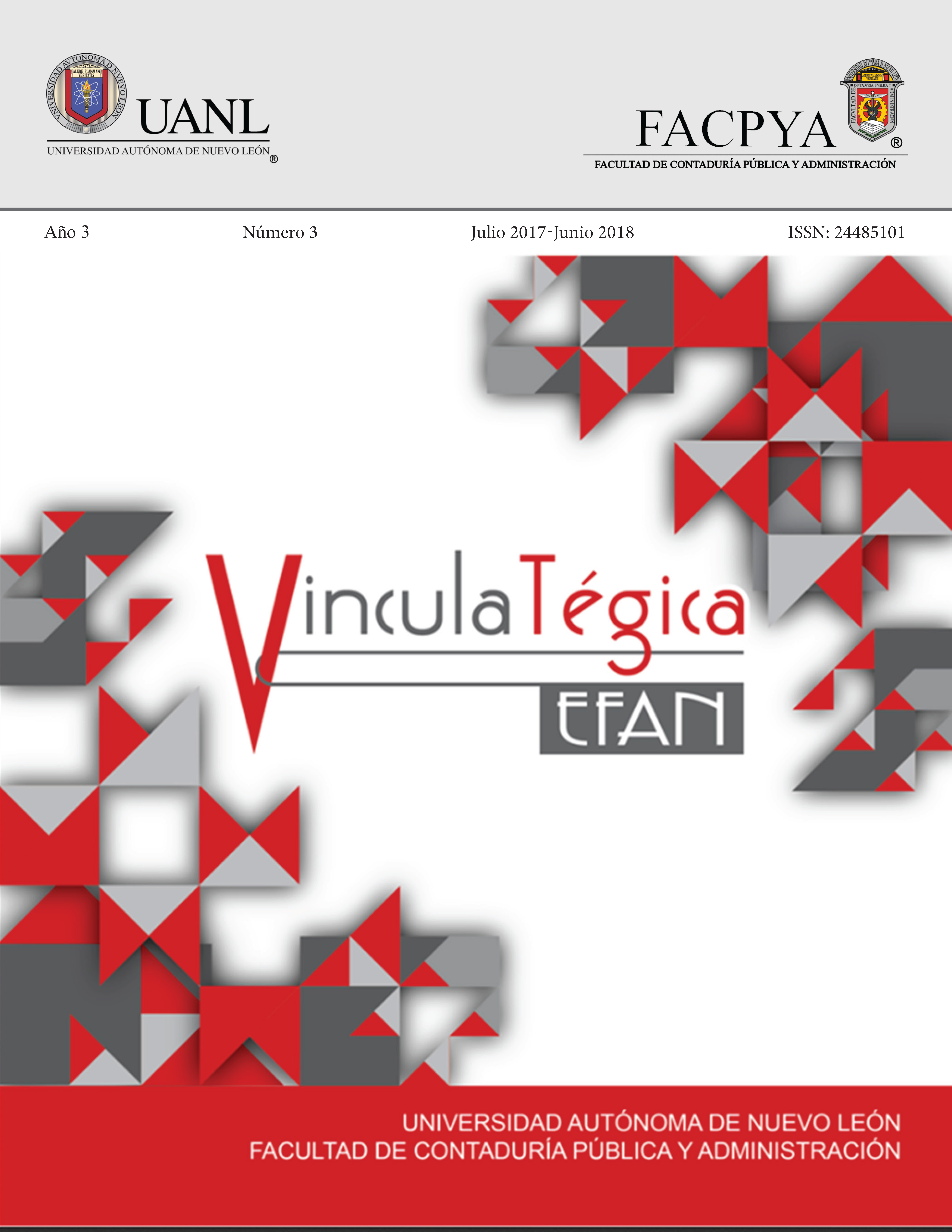Maquiladoras de Ciudad Juárez, las inversiones un obstáculo para la sustentabilidad global
DOI:
https://doi.org/10.29105/vtga3.3-1072Keywords:
Social awareness, Vision of the future.Abstract
Identify the sustainability strategies of the main maquiladoras of Ciudad Juárez that allow to offer value at a global level. The methodological design consisted of a study of collective cases, through semi-structured interviews and analysis by categories to those responsible for the sustainability of these factories. The interviewees consider investment the main obstacle, on the part of the respective matrix, in order to generate value at a global level and reduce the social impact of their daily performance. They consider that complying with voluntary and mandatory regulations is sufficient; ISO 26000 and ISO 14001 in the environmental and the Official Mexican and international standards. The social conscience demands a business behavior, efficient and innovative that allows to diminish the impact of the operation of the maquiladora industry. It is advisable to evaluate the 318 investment in sustainability in the long term, thereby avoiding future problems that deteriorate the corporate image and limit international business
Downloads
References
Ball, D., (2010). International Business.The change of global competition.Twelfthedition. New York: McGraw-Hill Irwin
Beriguete, A. (2013). Escuela de organización de industrial. Recuperado el 13 de octubre de 2016, de La Innovación y la Responsabilidad Social en la Empresas: http://www.eoi.es/blogs/mtelcon/2013/02/05/la-innovacion-y-laresponsabilidad-social-en-las-empresas/
Campo, N (2009). La inversión ambiental en las empresas. El Cuaderno - Escuela de Ciencias Estratégicas. Vol. 3 N° 6 P. 235 - 249
Castaño, L., y Gutiérrez, M. (2011). Propuesta para determinar la Competitividad en las empresas del sector comercial del área metropolitana centro occidente AMCO. Uruguay: Universidad Tecnológica de Pereira.
Chavarría L., L., y Cuevas Z., I. (2012). La gestión ambiental como estrategia para minimizar los costos. 1-21., recuperado de https://www.occ.pt/news/PENCUSTOS/pdf/091.pdf, noviembre de 2016.
Climent Sanjuán, V. (2006). Sociedad del riesgo: producción y sostenibilidad. Barcelona: Universidad de Barcelona, 121-140. DOI: https://doi.org/10.5565/rev/papers.2052
Dubbink, W., & Smith, J. (2011).A Political Account of Corporate Moral Responsibility.EthicalTheory and Moral Practice. 14(2), pp. 223-246 DOI: https://doi.org/10.1007/s10677-010-9235-x
Durán, G. (2011). Empresas y Gestión ambiental en el marco de la responsabilidad social corporativa. Universidad Autónoma de Madrid, 129-136.
Fernández, L. (2006). ¿Cómo analizar datos cualitativos? ButlletíLaRecerca, 1-13.
Gálvez, M. (2013). La RSE como factor clave para aumentar la competitividad. Compromiso RSE, 76-84.
Gómez, G. G. (2012). Del consumo al consumismo. Universidad de Tarapacá, 1-11.
Johnson, D., y Turner, C. (2010). International Business.2 end edition. New York. Routledge DOI: https://doi.org/10.4324/9780203861615
Koontz, H., Weihrich, H., y Cannice, M (2012). Administración, una perspectiva global y empresarial. 14ª. Edición. China: Mc Graw Hill.
Lipovetsky, G. (1990). El imperio de lo efímero. Barcelona: Anagrama.
Martínez, P. C. (2006). El método de estudio de caso: estrategia metodológica de la investigación científica. Pensamiento y Gestión, 165-193.
Muñiz, M. (2002). Estudios de caso en la investigación cualitativa. Nuevo León: Universidad de Nuevo León.
Ortiz, F. G. (2003). Diccionario de metodología de la investigación científica. México DF: Editorial Limusa.
Oster, S. (1999). Análisis moderno de la competitividad. Tercera edición. México: Oxford
Porter, M (1990). The Competitive Advantage of Nations. New York: Free Press DOI: https://doi.org/10.1007/978-1-349-11336-1
Porter, M. E. (2005). Ventaja Competitiva. México: Compañía Editorial Continental.
Quintanilla, A. y Arfeuille, G. (2011). Potencial eléctrico de los recursos energéticos renovables en México. En González, M., Muñoz, E., y Ortega, A (Coords). Hacia la sustentabilidad ambiental de la producción de energía en México. Baja California Sur: Colegio de la Frontera Norte.
Scherer, A. G., y Palazzo, G. (2007). Toward a Political conception of corporate responsibility: Business and society seen froom a habermasian perspective. TheAcademy of ManagmentReview, 1096-1120.
Rebollo, M. (1996). Responsabilidad de las Administraciones Públicas en España. Cuadernos de Derecho Judicial, 11-24.
Sabino, C. (1992). El proceso de la investigación. Caracas: Panapo.
Sandoval Cabrera, P. (2015). Responsabilidad ambiental empresarial, coeficiencia y competitividad. Pyme y sustentabilidad, 3337.
Samuelson, W., y Marks, S (2012). ManagerialEconomics. SeventhEdition. USA: Wiley.
Scherer, A. G., y Palazzo, G. (2007). Toward a Political conception of corporate responsibility: Business and society seen froom a habermasian perspective. The Academy of Managment Review, 1096-1120. DOI: https://doi.org/10.5465/amr.2007.26585837
Shimizu, T., Monteiro, M., y Barbin, J. (2008). Developing Strategies for Competitive Advantage.En Developing Successful ICT Strategies. Rahman, H. Hersey-New York: Information Science Reference. DOI: https://doi.org/10.4018/978-1-59904-654-9.ch003
Skilton, P., and Purdy, J. (2017).Authenticity, Power, and Pluralism: A Framework for Understanding Stakeholder Evaluations of Corporate Social Responsibility Activities. Business EthicsQuarterly 27:1 pp. 99–123 DOI: https://doi.org/10.1017/beq.2016.60
Spradley, J. (1980). Participant Observation, 134-154.
Spring, M. (1990). Los países parias.Chile: Editorial Andres Bello.
Stake, R. E. (2005). Investigación con estudio de casos. Madrid: Morata.
Torres, A. D., García, R. A., & Jiménez, C. (2011). Eco-innovación, fuente de ventaja competitiva. Congreso Internacional de investigación en Ciencias Administrativas, 280-294.
Trujillo, A. M., & Vélez, B. R. (2006). Responsabilidad ambiental como estrategia para la perdurabilidad empresarial. Universidad y Empresa, pp. 291-308.
Downloads
Published
How to Cite
Issue
Section
License

This work is licensed under a Creative Commons Attribution 4.0 International License.
a). Authors keep copyright and give the journal the right of the first publication of the work under a Creative Commons attribution license. This license allows others to share the work as long as original authorship and initial publication in this journal is acknowledged.
b). Authors may make other independent and additional contractual agreements for the non-exclusive distribution of the version of the article published in this journal (e.g., include it in an institutional repository or publish it in a book) as long as they clearly indicate that the work was published for the first time in this journal.







